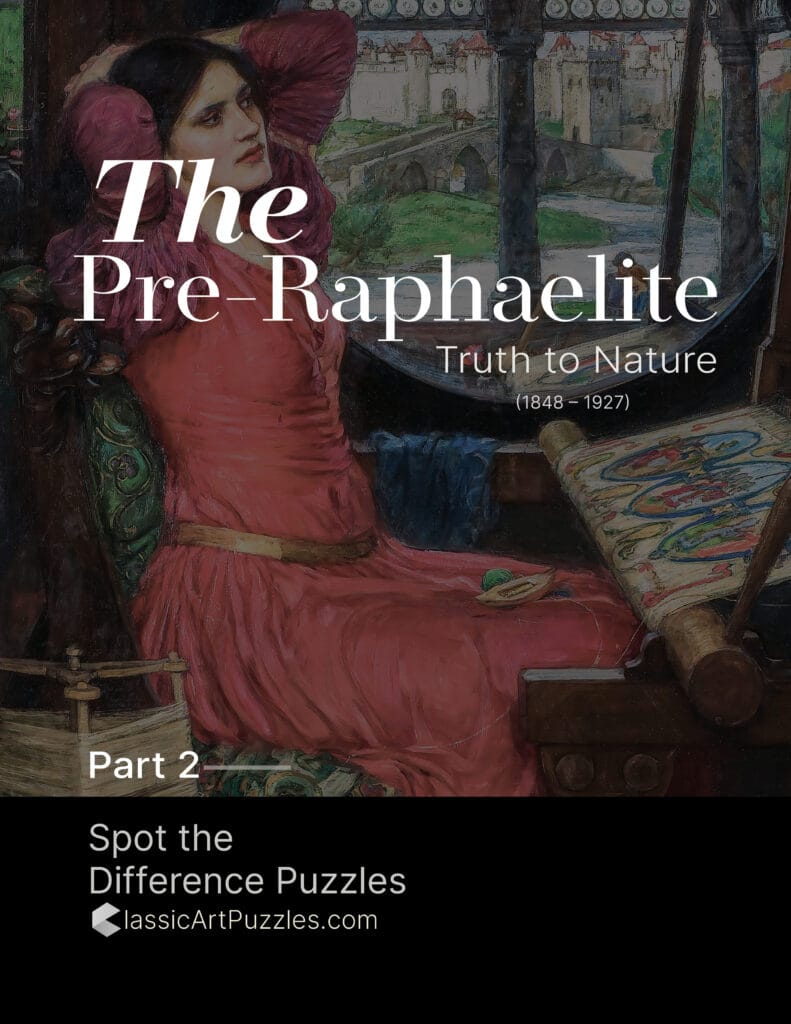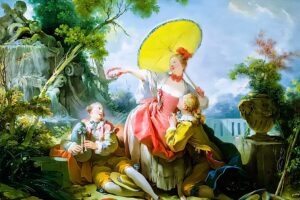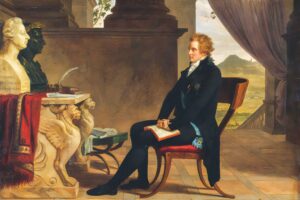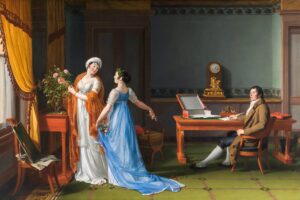Table of Contents
Overview
Painted in 1888 by John Roddam Spencer Stanhope (1829–1908), Pine Woods at Viareggio captures the everyday rhythms of rustic life along the Tuscan coast. Three young women gather pinecones and kindling within a forest of slender trees, their poses both natural and sculptural. Barefoot and dressed in simple garments, they represent the dignity of rural labor and the timeless harmony between humanity and nature.
Though created later in Stanhope’s career, the painting reflects the Pre-Raphaelite ideals he cherished throughout his life: jewel-like color, precision in detail, and symbolic undertones. The work balances observation with allegory, portraying not only a scene of gathering but also a meditation on community, resourcefulness, and the cycles of the earth.
When first shown, it was praised for its luminous palette and classical stillness. Today, it remains an evocative blend of rustic realism and spiritualized beauty.
The Artist
John Roddam Spencer Stanhope (1829–1908) was a British painter closely associated with the Pre-Raphaelites. A cousin of John Spencer Stanhope, he was deeply influenced by Edward Burne-Jones and Dante Gabriel Rossetti. His art combined mythological, biblical, and allegorical themes with an emphasis on symbolic depth and glowing color. Later in life, he moved to Florence, where Italian landscapes and light profoundly shaped his style.
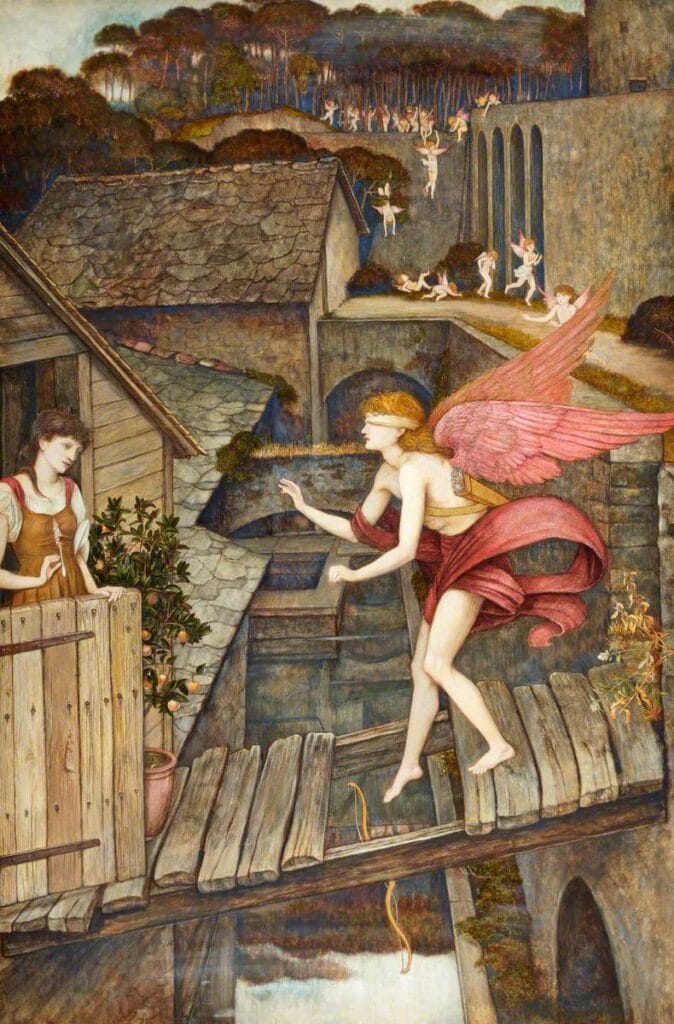
The Story Behind the Painting
A Rustic Gathering
The scene is set in Viareggio, a coastal Tuscan town surrounded by pine forests. Women collect pinecones and branches, their labors rendered with dignity.
Symbolism of Labor
The act of gathering wood symbolizes both sustenance and the continuity of rural traditions. Their bare feet and simple clothing suggest humility, yet their grace elevates them into timeless figures, almost like mythological nymphs of the woodland.
Italian Influence
By 1888, Stanhope had settled in Italy permanently. The golden light, slender trees, and clear atmosphere reflect the Italian environment he had come to embrace, blending naturalistic observation with symbolic suggestion.
Composition and Subjects
The Central Trio
Three women dominate the foreground: one balancing a pine-laden basket, another resting her foot on bundled kindling, and a third adjusting a heavy sack. Their arrangement recalls classical friezes, yet they are grounded in reality.
The Pine Forest
The vertical rhythm of trees frames the figures, creating both enclosure and repetition. The forest becomes not just a setting but a stage for human activity.
Figures in the Distance
Other women can be seen deeper in the woods, reinforcing the communal nature of labor and extending the sense of space.
Art Style and Techniques
Pre-Raphaelite Precision
Stanhope’s meticulous rendering of pinecones, bark, and foliage reflects the Pre-Raphaelite devotion to “truth to nature.”
Color and Light
The warm earth tones and glowing skin contrast with the cool greens and browns of the pinewood, producing harmony and balance.
Classical Poise
Though depicting rustic women, their stances recall classical sculpture, suggesting a union of realism with timeless idealism.
Featured in Our Collection
Pine Woods at Viareggio is part of our Pre-Raphaelite Spot-the-Difference Puzzle Flipbook P2. Its wealth of textures — pine needles, baskets, woven garments — makes it both challenging and rewarding as a puzzle, offering layers of discovery with each viewing.
A Tuscan wood, the golden floor scattered with pinecones, young women bent in graceful labor, and the rhythm of trees rising around them. In Stanhope’s Pine Woods at Viareggio, rustic toil becomes timeless poetry.
More About Artist
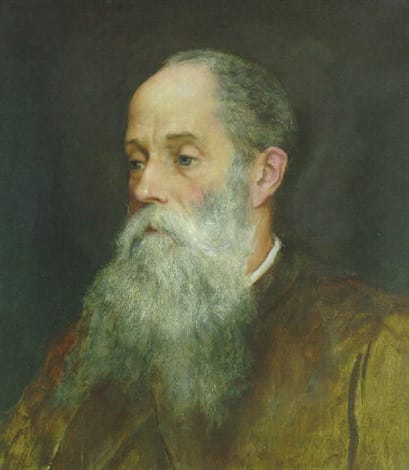
John Roddam Spencer Stanhope (January 20, 1829 – August 2, 1908) was an English artist associated with the second wave of the Pre-Raphaelite movement. Born into an aristocratic family in Cawthorne, Yorkshire, he was educated at Rugby School and Christ Church, Oxford. Despite his privileged background, Stanhope pursued a career in art, training under George Frederic Watts and traveling extensively, including trips to Italy and Asia Minor.
Artist Style and Movement
Stanhope’s work is typically classified within the later Pre-Raphaelite and Aesthetic movements of Victorian art. He worked across various media—oil, watercolor, fresco, tempera—and his subjects ranged from mythological and allegorical themes to biblical scenes and contemporary life. His early paintings featured highly original narrative compositions, which later evolved towards a more symbolic and aesthetic style influenced by broader Victorian artistic trends.
The Pre-Raphaelite Society continues to explore and share the legacy of this remarkable movement.
Artwork Profile
- Thoughts of the Past (1859), his first exhibited painting, depicting a contemplative woman by a window overlooking the Thames.
- The Shulamite: (Pastoral Scene with Lambs) (c. 1878), a serene and lyrical pastoral scene exemplifying his Pre-Raphaelite style.
- The Shulamite: (Bridal Procession) (c. 1882), depicting the procession with rich symbolism and ornate detail, continuing his Pre-Raphaelite themes.
- Penelope (1864), illustrating the faithful wife from Homeric legend in the detailed and expressive Pre-Raphaelite manner.
- Winnowing (c. 1880), portraying agricultural life with symbolic overtones typical of his narrative approach.
- Juliet and Her Nurse (c. 1860), a literary subject rich with emotional and dramatic qualities favored by Pre-Raphaelites.
- Why Seek ye the Living Among the Dead (1870–1899), a powerful biblical scene reflecting later symbolic and aesthetic tendencies.
- Love and the Maiden (1877), a romantic and allegorical composition showcasing his mature style.
- Charon and Psyche (1883), a mythological painting exploring themes of love and the afterlife.
- Pine Woods at Viareggio (1888), a landscape reflecting his time in Italy with delicate naturalism.
- The Gentle Music of a Bygone Day (1873), a nostalgic genre painting evoking memories and emotion.
- The Waters of Lethe by the Plains of Elysium (1880), a symbolic work referencing classical mythology and the afterlife.
John Roddam Spencer Stanhope’s artistic career reflects a rich engagement with the ideals of the Pre-Raphaelites, combined with a move towards aesthetic symbolism in later years. His work, characterized by technical skill and narrative depth, secured him a distinctive place in Victorian art history. Living much of his later life in Florence, he influenced subsequent artists including his niece Evelyn De Morgan, solidifying his legacy as a key figure bridging English Romanticism and Aestheticism.phasize classical virtue and patriotic sacrifice, reflecting the cultural ideals of his age.

